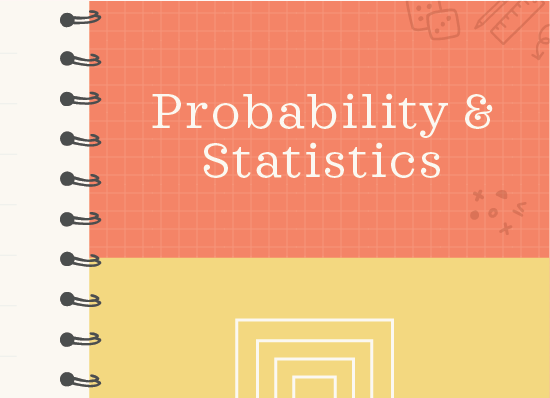"At least" and "at most," and mean, variance, and standard deviation
“At least” and “at most” probability
We can do more than just calculate the probability of pulling exactly ???3??? red marbles in ???5??? total pulls.
For any binomial random variable, we can also calculate something like the probability of pulling at least ???3??? red marbles, or the probability of pulling no more than ???3??? marbles.
Hi! I'm krista.
I create online courses to help you rock your math class. Read more.
What we want to know is that the probability of pulling at least ???3??? red marbles is the probability that we pull ???3???, or ???4???, or ???5??? red marbles, which is simply the probability of each of these, all added together.
???P(\text{at least }3\text{ reds in }5\text{ pulls})=P(3\text{ reds})+P(4\text{ reds})+P(5\text{ reds})???
???P(\text{at least }3\text{ reds in }5\text{ pulls})=\binom{5}{3}\left(\frac13\right)^3 0.67^2???
???+\binom{5}{4}\left(\frac13\right)^4 \left(\frac23\right)^1+\binom{5}{5}\left(\frac13\right)^5 \left(\frac23\right)^0???
???P(\text{at least }3\text{ reds in }5\text{ pulls})=(10)\left(\frac13\right)^3\left(\frac23\right)^2???
???+(5)\left(\frac13\right)^4\left(\frac23\right)^1+(1)\left(\frac13\right)^5\left(\frac23\right)^0???
???P(\text{at least }3\text{ reds in }5\text{ pulls})\approx0.1646+0.0412+0.0041???
???P(\text{at least }3\text{ reds in }5\text{ pulls})\approx0.2099???
???P(\text{at least }3\text{ reds in }5\text{ pulls})\approx21\%???
In the same way, the probability of pulling at most ???3??? red marbles would be the probability of pulling ???1???, or ???2???, or ???3??? red marbles, all added together.
If we’re calculating the probability of at least one success or at least one failure, we can use these formulas:
???P(\text{at least 1 success})=1-P(\text{all failures})???
???P(\text{at least 1 failure})=1-P(\text{all successes})???
This is because all probability distribution functions must add up to ???1???.
How to calculate the probability of “at least” and “at most” events
Take the course
Want to learn more about Probability & Statistics? I have a step-by-step course for that. :)
Probability of getting at least 1 “heads” on 5 coin flips
Example
Find the probability that we get at least ???1??? heads on ???5??? coin flips.
We can actually simplify this problem a lot by realizing that every single set of ???5??? coin flips will have at least one heads, unless every one of the ???5??? flips is tails: ???TTTTT???. The probability of getting ???5??? tails in a row is
???P(TTTTT)=\left(\frac12\right)\left(\frac12\right)\left(\frac12\right)\left(\frac12\right)\left(\frac12\right)=\frac{1}{32}???
The probability of getting “at least one heads” is the same as the probability of not getting “all tails.” Therefore, since total probability is always equal to ???1???, we can say that the probability of at least one heads is
???P(\text{at least 1 heads})=1-\frac{1}{32}=\frac{31}{32}???
Let’s do another example where we find an “at most” probability for a binomial random variable.
The probability of getting “at least one heads” is the same as the probability of not getting “all tails.”
Example
Let ???X??? be a binomial random variable with ???n=10??? and ???p=0.30???. Find ???P(X\le 5)???.
The variable ???X??? follows a binomial distribution, but instead of finding the probability of exactly ???k??? successes in ???n??? trials, we’re asked to find the probability of ???k??? or fewer successes in ???n??? trials. Specifically, find the chance of ???5??? or fewer successes in ???10??? trials, where the probability of success on any one trial is ???p=0.30???.
Find the probability of ???0??? successes, ???1??? success, ???2??? successes, etc., up to ???5??? successes, and then find the sum of those probabilities.
???P(X\le 5)=P(X=0)+P(X=1)+P(X=2)+P(X=3)+P(X=4)+P(X=5)???
To find the probability for each value of ???k???, we use the binomial probability formula.
???P(k\text{ successes in }n\text{ trials})=\binom{n}{k}p^k(1-p)^{n-k}???
So the probability ???P(X\le 5)??? is
???P(X\le 5)=\binom{10}{0}(0.30)^0(1-0.30)^{10}+\binom{10}{1}(0.30)^1(1-0.30)^{9}???
???+\binom{10}{2}(0.30)^{2}(1-0.30)^8+\binom{10}{3}(0.30)^{3}(1-0.30)^7???
???+\binom{10}{4}(0.30)^{4}(1-0.30)^6+\binom{10}{5}(0.30)^{5}(1-0.30)^5???
???P(X\le 5)=0.9527???
Mean, variance, and standard deviation
The mean of a binomial random variable ???X??? can be expressed as ???\mu_X???. The mean is also called the expected value, and that’s indicated as ???E(X)???. Either way, the mean is given by
???\mu_X=E(X)=np???
where ???n??? is the fixed number of independent trials, and ???p??? is the probability of a success. The variance of a binomial random variable ???X??? is given by
???\sigma_X^2=np(1-p)???
Standard deviation is the square root of the variance and is therefore given by
???\sqrt{\sigma_X^2}=\sqrt{np(1-p)}???
???\sigma_X=\sqrt{np(1-p)}???
If we continue with our example of the number of heads we get on ???5??? coin flips, we can say that the number of trials ???n??? is ???5???, and the probability of success (getting heads) is ???p=0.5???. Therefore, the mean is
???\mu_X=np???
???\mu_X=5(0.5)???
???\mu_X=2.5???
The variance is
???\sigma_X^2=np(1-p)???
???\sigma_X^2=5(0.5)(1-0.5)???
???\sigma_X^2=2.5(1-0.5)???
???\sigma_X^2=2.5(0.5)???
???\sigma_X^2=1.25???
And the standard deviation is
???\sigma_X=\sqrt{np(1-p)}???
???\sigma_X=\sqrt{1.25}???
???\sigma_X\approx1.12???






